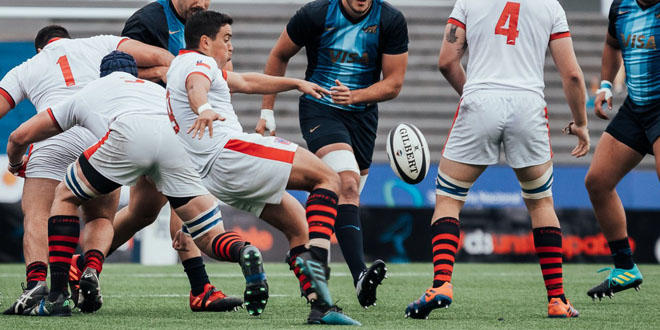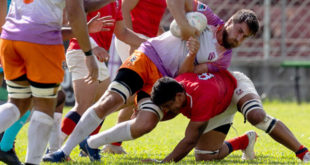There were impressive performers in the 2020 South American 4 Nations. Players from Argentina, Brazil, Chile and Uruguay are all in the discussion for the competition’s Dream Team. The leading player per position has been determined on a comparative basis. His personal contribution overrides the team performance.
Click here to access the ARN tournament page.
2020 SOUTH AMERICAN 4 NATIONS – DREAM TEAM
1 – Javier Carrasco (Chile)
Chile genuinely emerged as a notable team in the competition. The level of play was both better than in recent years and optimistic for the future. One such instance of a young player who stooging out is Javier Carrasco. The loose head gave Chile an excellent platform in the scrum. He impressed in general play with a busy workload.
2 – Ignacio Ruiz (Argentina)
Argentina went into the tournament with Leonel Oviedo as their starting hooker. He scored a try early, but left injured after one quarter in game one. His replacement, Ignacio Ruiz, took the bull by the horns. Ruiz established himself as a player for the future, scoring five tries in three matches. No other player scored more than two tries.
3 – Francisco Minervino (Argentina)
Several players impressed at tight head. Matías Dittus was excellent when he played. A collision limited his game-time. Had it not then he could well have been chosen. Francisco Minervino was another standout. He played matches in both prop positions. The 21-year-old’s performance against Uruguay was that of a man on a mission. It was the kind of match that Los Jaguares’ staff will certainly have noticed.
4 – Javier Eissmann (Chile)
Look no further than Javier Eissmann then and now to consider the impact of Chile’s High Performance Centers and Selknam. A vivd aspect of Chile’s vast improvement this year was the fitness and shape of the players. Eissmann bulked-up in size and also looked to possess a sharper skill-set. It provided him with the means to sharpen his game. Chile benefitted from him offensively and defensively. Moreover, he started every match.
5 – Franco Molina (Argentina)
Also starting throughout the competition was Franco Molina. The Argentine second-rower was a stand-out; his work in the collision area was second-to-none. His ball-carrying was also impressive. He was a Ceibos player this year, and realistically is a Jaguar in the waiting.
6 – Martín Sigren (Chile)
The Chilean captain led his team superbly. Martín Sigren motivated his team both on and off the field. His tackling and ball-carrying were both excellent. This was furthered by his double; he scored tries against both Uruguay and Brazil. He also impressed against Argentina; a match wherein Chile were three minutes away from writing history.
7 – Ignacio Silva (Chile)
Sigren and Silva are a highly useful duo. The Chilean flankers both offer plenty in attack and on defense. Indeed, Silva was a try scorer against Uruguay. ARN notes that Silva was the leading performer in a 6 shirt. Both Lautaro Bavaro and Leandro Segredo were also busy, though Silva performed demonstrably better than both established players.
8 – André Arruda (Brazil)
Players from all four countries put themselves forward in this position. RWC players Javier Ortega Desio and Manuel Diana were both busy workers. The pick of the lot, though, goes to Brazil’s André Arruda. His try against Chile ultimately sees him just ahead.
9 – Marcelo Torrealba (Chile)
Fans of Austin Gilgronis will be very pleased with the performance of their player. Marcelo Torrealba organized player very effectively. He made good decisions about when to pass and when to kick. He actively put his team in the right places. He also managed the defense well; barking orders at the forwards.
10 – Santiago Videla (Chile)
There were several candidates for fly half. We have ultimately gone for a player who impressed throughout the tournament. Santiago Videla was solid at both fly half and inside center. Martin Elías also impressed, but he started fewer matches and scored less points than Videla. The Chilean ticked boxes across the board. He defended well and was a solid decision maker as a pivot.
11 – Federico Favaro (Uruguay)
The tournament’s leading scorer, Federico Favaro starts with a bang. His 20 points against Brazil was the highest by any player in the tournament. He also scored an excellent try against Chile. He was a replacement against the Argentina XV, and came on too late to have a real impact. In short, when he played Uruguay were the better for it.
12 – Andrés Vilaseca (Uruguay)
Uruguayan skipper Andrés Vilaseca played well. His scored a very good try against the Argentina XV, but it was his general play that stood out the most. His ball-carrying made a difference. Before he came on against Brazil, the Uruguayans were lacking go-forward ball in the backs. He had a fine tournament and did his best to lift a team featuring plenty of rookies.
13 – Domingo Saavedra (Chile)
No outside center had a bad tournament. Regular winger Nicolás Freitas had a strong tournament in the mid-field, while Felipe Sancery and Tomás Cubilla both led their teams well. However, the best performer was Domingo Saavedra. His performance against the Argentina XV was a contender for the greatest game’s from a Chilean 13 against their eastern neighbors. He defended brilliantly and worked endlessly when on the field.
14 – Matías Osadczuk (Argentina)
For Matías Osadczuk the switch from Los Pumas 7’s to the Argentina XV was a success. He is being groomed for the 2021? Tokyo Olympics, though there will certainly be an interest from Los Jaguares and Los Ceibos. Osadczuk scored two excellent tries in the tournament. His play affected the Argentina XV, providing more depth to their play.
15 – Rodrigo Fernández (Chile)
The top performing fullback was Rodrigo Fernández. He was a try scorer against Argentina and had a crucial asset try against Brazil. In general play he was also impressive. He was reliable under the high-ball, kicked well and ran well from the deep, and proved to be an option at kicking from goal from long-range.
 Americas Rugby News Rugby news from across the Americas!
Americas Rugby News Rugby news from across the Americas!




